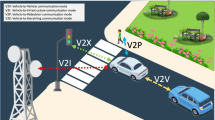Abstract
In ubiquitous environments, the Intelligent Transportation System (ITS) protocol is a typical service used to improve the quality of life for humans. The Vehicular Ad-hoc Network (VANET) protocol, a part of ITS, needs further study with regards to its support for high reliability, high speed mobility, data transmission efficiency, and so on. The IEEE 802.11 standard provides a high data rate channel, but it was designed for peer-to-peer network protocols. IEEE 802.11p also provides a high data rate channel, however, it only facilitates communication between roadside and on-board equipment. A VANET has characteristics that enable its topology to change rapidly; it can also be expanded to a multi-hop range network during communication. Therefore, the VANET protocol needs a way to infer the current topology information relating to VANET equipped vehicles. In this paper, we present the Efficient Beacon Scheduling (EBS), and propose a method to resolve the problem of beacon collisions in VANET through the use of this EBS protocol. Evaluation of the performance of EBS by means of both mathematical analyses and simulation experiments indicate that the proposed method can effectively reduce beacon collisions and improve the throughput between vehicles in VANET systems.













Similar content being viewed by others
Abbreviations
- WAVE:
-
Wireless access in vehicle environments
- VANET:
-
Vehicular Ad-hoc Networks
- DFSA:
-
Dynamic framed slotted Aloha
- WiMedia:
-
Industry special interest group promoting UWB device standardization
- UWB:
-
Ultra-WideBand
References
Bilstrup, K. (2007). A survey regarding wireless communication standards intended for a high-speed vehicle environment. School of Information Science, Computer and Electrical Engineering, Halmstad University, Sweden.
Chien-Tung, Lu, Chang, Chih-Lun, Liu, I-Hsien, & Li, Jung-Shian. (2014). Novel advanced broadcast scheme for efficient safety message collision alleviation in vehicular networks. Wireless Personal Communications, 77(4), 2793–2816.
Sepulcre, M., & Gozalvez, J. (2012). Contextual and applications-aware communications protocol design for vehicle-to-vehicle communications. Wireless Personal Communications, 70(4), 1505–1524.
Ding, R., Li, X., Zhang, Y., & Gerla, M. (2012). Broadcast-first service scheduling scheme for vehicle-roadside communication. Wireless Personal Communications, 68(4), 1903–1922.
IEEE 802.11. (2007). IEEE Std. 802.11–2007, Part 11: Wireless LAN MAC and PHY Specifications.
Torrent-Moreno, M. (2007). Inter-vehicle communications: Achieving safety in a distributed wireless environment: Challenges, systems and protocols. PhD dissertation, Universitätsverlag, Karlsruhe.
Zang, Y., Stibor, L., Walke, B., Reumerman, H. & Barroso, A. (2007). Towards broadband vehicular ad-hoc networks—The vehicular mesh network (VMESH) Mac protocol. In Proceedings of IEEE Wireless Communications and Networking Conference, Hong Kong, pp. 417–422.
WiMedia Alliance. (2009). MAC-PHY interface Specification. WiMedia ALLIANCE, RELEASE 1.5.
IEEE 802.11p. (2009). IEEE Std. 802.11p/D7.0, Amendment 7: Wireless access in vehicular environments.
Jiang, D. & Delgrossi, L. (2008). IEEE 802.11p: Towards an international standard for wireless access in vehicular environments. In Proceedings of IEEE VTC-Spring.
IEEE 1609.1. (2006). IEEE Std. 1609.1-2006, IEEE trial-use standard for wireless access in vehicular environments (WAVE)—Resource Manager.
IEEE 1609.2. (2006). IEEE Std. 1609.2-2006, IEEE trial-use standard for wireless access in vehicular environments—Security services for applications and management messages.
IEEE 1609.3. (2007) IEEE Std. 1609.3-2007, IEEE trial-use standard for wireless access in vehicular environments (WAVE)—Networking services.
IEEE 1609.4. (2006). IEEE Std. 1609.4-2006, IEEE trial-use standard for wireless access in vehicular environments (WAVE)—Multi-channel operation.
IEEE 802.11a. (1999). IEEE Std. 802.11a-1999, Part 11: Wireless LAN medium access control (MAC) and physical layer (PHY) specifications. IEEE Std. 802.11a.
Cho, W. & Oh, H. S. (2011). A multi-hop communication scheme for IEEE 802.11p based V2V communication systems. In Communication and Networking. Springer.
Guerrero-Ibáñez, J. A., Flores-Cortés, C. & Zeadally, S. (2013). Vehicular ad hoc networks (VANETs): Architecture, protocols and applications. In Next-Generation Wireless Technologies. Springer.
Standards Committee. (2005). Wireless LAN medium access control (MAC) and physical layer (Phy) specifications: Amendment 8: Medium access control (MAC) quality of service enhancements. In IEEE Computer Society.
IEEE Std 802.11. (1997). Wireless LAN medium access control (MAC) and physical layer (PHY) specifications. In IEEE.
Tanenbaum, A. (2002). Computer networks, 4th ed. Prentice Hall PTR, pp. 372–375.
Hiroshi, H., & Ramjee, P. (2002). Simulation and software radio for mobile communications. London: Artech House Publishers.
Alabady, S. A., & Salleh, M. F. M. (2014). Analysis and throughput performance of IEEE 802.11 DCF in multi-hop wireless networks. Wireless Personal Communications, 78(2), 1465–1485.
Author information
Authors and Affiliations
Corresponding author
Rights and permissions
About this article
Cite this article
Joo, YI., Kim, ST. & Kim, JW. An Efficient Beacon Scheduling Scheme for Multi-hop in Vehicular Environments. Wireless Pers Commun 83, 1085–1099 (2015). https://doi.org/10.1007/s11277-015-2440-0
Published:
Issue Date:
DOI: https://doi.org/10.1007/s11277-015-2440-0




